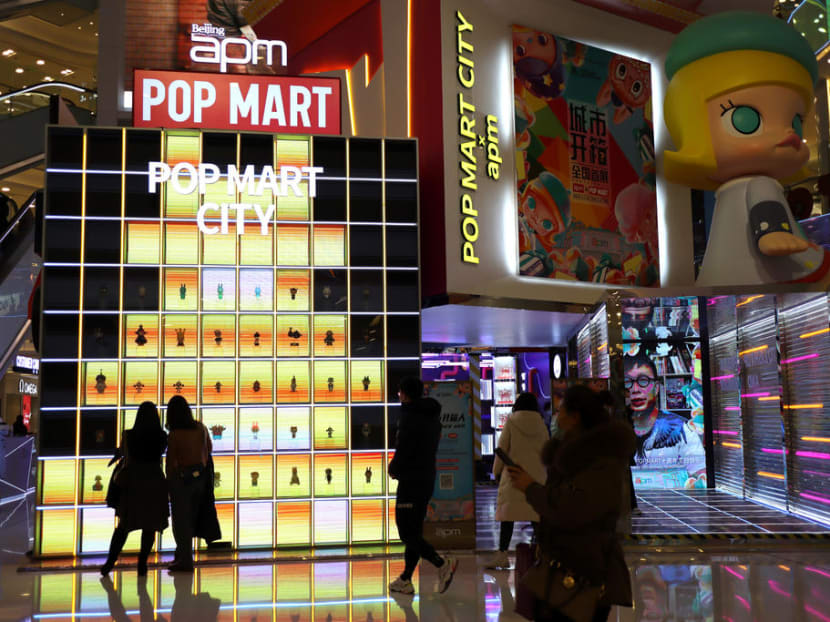Chinese millennials’ craze for toys spawns multimillion-dollar industry in blind boxes
HONG KONG — When Ms CC Sun first heard in 2019 about so-called blind box toys, collectible figures in mystery packaging, the 32-year-old engineer from Tianjin in China mocked her colleague for playing with children’s stuff.
HONG KONG — When Ms CC Sun first heard in 2019 about so-called blind box toys, collectible figures in mystery packaging, the 32-year-old engineer from Tianjin in China mocked her colleague for playing with children’s stuff.
Fast forward to last June. When Ms Sun saw Harry Potter figures were on offer, the big fan of the magical world created by J K Rowling did not hesitate to pay 59 yuan (S$12) each and got a palm-sized figurine of Professor McGonagall.
The toe-dip ended up costing her more than 2,000 yuan within a week to collect all 12 figurines in the series, including a limited-edition Harry Potter on a Firebolt broomstick.
Across the country, consumers like Ms Sun have turned the hobby into a craze and spawned an industry on its own.
The market for blind boxes could grow to 25 billion yuan in 2025 from about 3 billion yuan in 2019, according to Shenzhen-based consultancy Qianzhan Intelligence. The craze, though, attracted stinging criticism last month from several state-run media outlets, which likened it to gambling addiction.
Buyers of blind boxes do not know which figurine they will get until they unpack them. Some may get the thrill of winning sought-after characters. Others may be frustrated with ones they already have.
Getting the desired piece to complete a collection depends entirely on luck, or perhaps on the amount of money spent.
“It is like a jackpot when I finally unveiled the limited-edition item,” said Ms Sun, who has since spent some 10,000 yuan on other toy series over the past six months. “Not knowing what I can get brings extra joy. Who said grown-ups cannot play with toys?”
Retailers typically market them in trunks of 12 boxes, each in turn containing 12 blind boxes.
Each trunk of 144 blind boxes may contain one or more limited-edition figurines, the most sought-after item in a series of characters or toys. It may not contain any at all, leaving everything to chance.
Producers will never promise any special items in any trunk, according to Miniso Group.
The craze is not new. Some countries, including Belgium, have banned the controversial gaming feature known as “loot boxes”, where players are forced to make purchases without knowing the odds of getting a valuable or useful item.
The concept that is becoming wildly popular in China has similarities to Japan’s Gashapon vending machines from 60 years ago, which dispensed capsule toys.
China’s toymakers are betting on the country’s 500 million millennials and members of Generation Z, who are flush with disposable income and willing to spend on such indulgences.
Pop Mart International, widely regarded as the creator of the craze in China, has enamoured investors with its recent success.
The company’s shares closed at HK$81.35 (S$13.9) on Dec 31, 2020, more than doubling within 20 days of listing in Hong Kong.
“We certainly did not expect such an enthusiastic response (to Pop Mart’s shares),” said Mr Kenny Wen, wealth management strategist at Everbright Sun Hung Kai in Hong Kong. “The purchasing power for cute toys and the chase for limited editions (have been) insanely huge, beyond our imagination.”
The 15-to-35 age group is Pop Mart’s target segment as these consumers have a solid financial foundation, thanks to their parents, Pop Mart’s founder and chief executive officer Wang Ning told the South China Morning Post. “They pay for the self-expression, companionship and playfulness these toys can offer easily.”
On Tmall, some 200,000 consumers traded blind boxes on the site, spending 20,000 yuan each on average, according to a report in 2019 by the online platform.
The collection of figurines has overtaken trendy trainers and video games as the most popular hobby among consumers born after 1995, the report added.
The shopping binge has drawn more players, such as New York-listed Chinese variety lifestyle goods retailer Miniso to join the game.
Miniso, which used to retail toys for children, saw sales of the blind box figurines increase 10 per cent month on month since it launched the business last year, with sales totalling 25 million yuan by November.
The “satisfactory” sales resulted in the kick-off of Top Toy on Dec 18, which focuses on selling blind box toys and other art toys, setting it apart from its flagship Miniso variety stores.
The fever has spread to other areas. Museums, cafe chain Starbucks, convenience store FamilyMart and e-commerce giant Tencent Holdings have either offered their own blind box toys or collaborated with toymakers to harness the rising consumption power.
The British Museum even started a pop-up store in Shanghai, China in July, selling a range of Egyptian god figurines in blind boxes, while HKRI Taikoo Hui shopping centre rolled out an outdoor carnival surrounded by giant figures representing the most significant Japanese blind box art toy Sonny Angel during Christmas to attract foot traffic.
“Everyone is trying to participate in the ‘blind box’ party,” said Pedro Yip, partner in New York-based consultancy Oliver Wyman’s retail and consumer goods practice. “It is probably the best tool to woo young Chinese spenders who, unlike previous generations who might have suffered from poverty and unstableness, like adventure and (want to) explore unknown things.”
Even so, market observers have concerns whether the trend is sustainable. “The overspend and speculation, in particular, is clearly not what the central government is fond of. The biggest risk (of the business) lies in the possible tightened regulation,” said Everbright’s Mr Wen.
More than 400,000 such boxes were traded on Alibaba Group’s Xianyu online flea market in 2020 and some rare versions, originally bought for 40 or 50 yuan, can sell for several hundred US dollars. SOUTH CHINA MORNING POST










